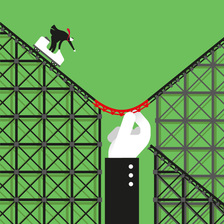
Change is hard, but when there is a clear end-state benefit for the organisation and the majority of its people, it is achievable. From selling the vision to winning hearts and minds, there are tried and tested change frameworks available to support the leader to achieve the desired transformation.
But what happens in a downsize when the end state means likely redundancy for the staff and in some cases the leader themselves? Do the same rules apply?
But what happens in a downsize when the end state means likely redundancy for the staff and in some cases the leader themselves? Do the same rules apply?
Who Wants to Lead a Downsize?
Within my experience of managing change, including major transformations as well as significant downsizings, success starts and ends with the leader and their effectiveness in leading their people through the change. With transformational change, it is easier. Who doesn’t want to be associated with improvement, growth and development? Leaders line up to take these career enhancing projects on, but downsizing is problematic, challenging and if we are honest, at times downright unpleasant to deal with.
Can you Afford to Delegate It?
Because of this, leaders might be tempted to turn a blind eye, preferring to align themselves with the future state. Or perhaps struggling to find a business rationale to invest time and resources in an area they plan to divest, they remove themselves from this space - leaving junior and often less equipped leaders, to bring this one home. But this ignores the effect on performance of the downsizing; the impact on reputation if it is handled badly and the negative legacy felt by the survivors that can infect the entire organisation's culture, if left unchecked.
How do you Succeed?
So what can the leader do? Well here is a clue, it’s more than just chairing the project board, making sure the milestones are being met and putting processes in place. There are project managers that can cover this off. For leaders it’s about doing what you do best, creating a climate to succeed. In a transformation, this is all about vision, momentum and celebrating success. In a downsizing it is more about adaptability, motivation and reassurance.
Understand the Climate
To understand the downsizing climate, let us look at its psychological impact in terms of a threat: a threat to the organisation and to individuals who will lose their jobs. When we are threatened, the typical psychological reaction is fight or flight; we get angry or we run away. However, there is very little an individual can do to fight downsizing, although some try, and very little opportunity for them to leave immediately, as they need to stay to receive their payoff.
Watch the Behaviours
So what happens is a mechanistic shift towards rigidity in behaviour, which functions as protection. For the individual this manifests itself as a shutdown, they are physically present but mentally checked out, discretionary effort is switched off; they are just going through the motions. At the organisational level a shutdown also occurs to deal with the perceived threat; control is centralised, resources restricted and information flow reduced. This is a toxic combination of behaviours that compound the situation and polarise the two groups, which in turn creates more rigidity. As communication deteriorates, trust is eroded, uncertainty and anxiety increases. A vicious cycle.
Break the Cycle
Breaking the cycle requires a high level of emotional intelligence and a willingness to behave in ways that may seem counter intuitive in a highly charged environment. For the leader it is about knowing when to step out of the process, what to let go of, how to reduce control. It is about communicating more, increasing flexibility and adaptability to situations. There is no rulebook, only judgement. If the leader reduces the perceived threat by behaving in a way that signals reassurance, empathy and engagement, others will mirror this behaviour. If the leader reduces control and creates more certainty, people will begin to move past un-resourceful states of denial and anger into a more positive state of acceptance of the change ahead, even if that change includes their departure from the organisation.
Show your Mettle and Grow
At the end of a downsizing there are few public accolades for the leader, but leading a downsizing is a real test of a leader’s mettle; a chance for a leader to show their capability, their adaptability and strength under fire. It’s an opportunity for the leader and the organisation to showcase its values, and enhance its reputation, if delivered well. It is also at a personal level the chance for the leader to develop and grow. After all if you can lead people through the hard times, just imagine what you will achieve when it is time to create and transform again.
If you are facing a change challenge and would like some support, call me on 07927 408626 or email to set up a time to talk.
Within my experience of managing change, including major transformations as well as significant downsizings, success starts and ends with the leader and their effectiveness in leading their people through the change. With transformational change, it is easier. Who doesn’t want to be associated with improvement, growth and development? Leaders line up to take these career enhancing projects on, but downsizing is problematic, challenging and if we are honest, at times downright unpleasant to deal with.
Can you Afford to Delegate It?
Because of this, leaders might be tempted to turn a blind eye, preferring to align themselves with the future state. Or perhaps struggling to find a business rationale to invest time and resources in an area they plan to divest, they remove themselves from this space - leaving junior and often less equipped leaders, to bring this one home. But this ignores the effect on performance of the downsizing; the impact on reputation if it is handled badly and the negative legacy felt by the survivors that can infect the entire organisation's culture, if left unchecked.
How do you Succeed?
So what can the leader do? Well here is a clue, it’s more than just chairing the project board, making sure the milestones are being met and putting processes in place. There are project managers that can cover this off. For leaders it’s about doing what you do best, creating a climate to succeed. In a transformation, this is all about vision, momentum and celebrating success. In a downsizing it is more about adaptability, motivation and reassurance.
Understand the Climate
To understand the downsizing climate, let us look at its psychological impact in terms of a threat: a threat to the organisation and to individuals who will lose their jobs. When we are threatened, the typical psychological reaction is fight or flight; we get angry or we run away. However, there is very little an individual can do to fight downsizing, although some try, and very little opportunity for them to leave immediately, as they need to stay to receive their payoff.
Watch the Behaviours
So what happens is a mechanistic shift towards rigidity in behaviour, which functions as protection. For the individual this manifests itself as a shutdown, they are physically present but mentally checked out, discretionary effort is switched off; they are just going through the motions. At the organisational level a shutdown also occurs to deal with the perceived threat; control is centralised, resources restricted and information flow reduced. This is a toxic combination of behaviours that compound the situation and polarise the two groups, which in turn creates more rigidity. As communication deteriorates, trust is eroded, uncertainty and anxiety increases. A vicious cycle.
Break the Cycle
Breaking the cycle requires a high level of emotional intelligence and a willingness to behave in ways that may seem counter intuitive in a highly charged environment. For the leader it is about knowing when to step out of the process, what to let go of, how to reduce control. It is about communicating more, increasing flexibility and adaptability to situations. There is no rulebook, only judgement. If the leader reduces the perceived threat by behaving in a way that signals reassurance, empathy and engagement, others will mirror this behaviour. If the leader reduces control and creates more certainty, people will begin to move past un-resourceful states of denial and anger into a more positive state of acceptance of the change ahead, even if that change includes their departure from the organisation.
Show your Mettle and Grow
At the end of a downsizing there are few public accolades for the leader, but leading a downsizing is a real test of a leader’s mettle; a chance for a leader to show their capability, their adaptability and strength under fire. It’s an opportunity for the leader and the organisation to showcase its values, and enhance its reputation, if delivered well. It is also at a personal level the chance for the leader to develop and grow. After all if you can lead people through the hard times, just imagine what you will achieve when it is time to create and transform again.
If you are facing a change challenge and would like some support, call me on 07927 408626 or email to set up a time to talk.


